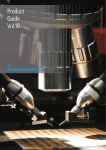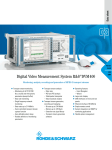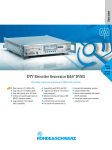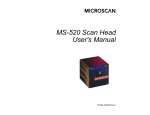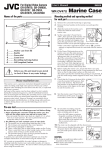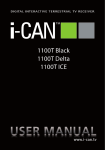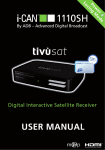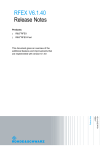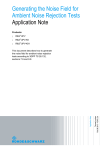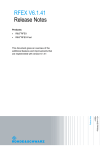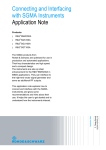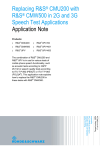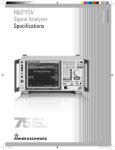Download Buffer Analysis MPEG-2 TS Analysis & Monitoring
Transcript
® ® ® ® ® ® Products: R&S DVM50, R&S DVM100, R&S DVM100L, R&S DVM120, R&S DVM400, R&S ETX Buffer Analysis MPEG-2 TS Analysis & Monitoring Application Note ® The new buffer analysis feature was introduced with firmware version 2.80 for the R&S DVM family. This application note describes this feature and explains how it represents a valuable asset to your daily business operations This application note first provides background information and then explains how ® monitoring and measurement have been implemented in the R&S DVM family. Subject to change – H. Gsoedl 11.2005 – 7BM53_0E Buffer Analysis Contents 1 2 3 4 5 6 7 8 9 10 11 12 13 7BM53_0E Overview ................................................................................................. 3 Introduction.............................................................................................. 3 Requirements.......................................................................................... 4 Transport Stream System Target Decoder in MPEG-2 .......................... 5 Buffer Architecture Overview .................................................................. 5 Different Buffer Models for Video, Audio and System Information.......... 6 MPEG-2 video.................................................................................... 6 Advanced video coding (AVC) video.................................................. 7 MPEG-1/2 audio................................................................................. 7 System information ............................................................................ 7 ® R&S DVM Graphical User Interface - Overview..................................... 8 ® R&S DVM Buffer Monitoring in Accordance with ETSI TR 101 290..... 12 MPEG-2 video.................................................................................. 12 MPEG-1/2 audio............................................................................... 13 ® R&S DVM Buffer Analysis for AVC Video ............................................ 14 Abbreviations......................................................................................... 15 Literature ............................................................................................... 15 Additional Information ........................................................................... 16 Ordering Information ............................................................................. 16 2 Rohde & Schwarz Buffer Analysis 1 Overview The new buffer analysis feature was introduced with firmware version 2.80 ® for the R&S DVM family. This application note describes this feature and explains how it represents a valuable asset to your daily business operations This application note first provides background information and then explains how monitoring and measurement have been implemented ® in the R&S DVM family. 2 Introduction Today, exceedingly large amounts of information are transmitted throughout the world via cable, satellite and terrestrial systems. Bandwidth limitations have made it necessary to optimize existing resources. This has led to the development of compression mechanisms such as MPEG-2 ISO/IEC 13818. As an example, this standard provides makes it possible to reduce the data rate for video and audio transmissions by removing unnecessary and redundant data. In this context, "unnecessary" means detailed information that cannot be detected by human senses. The term "redundant" means that the same information is present more than once. To explain the basic steps of digital television transmission, the following figure shows the generation and transmission principle: Fig. 1: Generation/transmission end To make the transmission of multiple services in one channel possible, the content of each program is divided into small packets after compression (encoder). These packets are “multiplexed” into one stream at a constant bit rate. The MPEG-2 transport stream (TS) has been created in accordance with ISO/IEC 18131. This content is fed to the transmitter. 7BM53_0E 3 Rohde & Schwarz Buffer Analysis The TS that is created may contain a large number of independent services. Each service often consists of more than one elementary stream (ES), e.g. video, audio, data. The bit rate in an ES commonly varies over time (e.g. I, B and P frames within a video ES). Consider the following example: If you look at the ES of video, you have specific elements commonly referred to as I frames (see [4]), which are large in size compared to the rest of the stream. Now assume that the TS used has a bit rate just high enough to hold one peak at any given time. If a second peak from another ES in the multiplex coincidentally occurs at the same time, the TS would not be able to hold and send out the data in a manner that allows a receiver to decode both sets of content properly. This leads to the challenge of fitting these services into one TS at a fixed limited bit rate. To ensure proper presentation on the terminal device, the encoder and the multiplexer have to create data streams that can be demultiplexed and decoded without any problems during presentation. The task is to determine how data of a specific ES can be delayed compared to others in such a manner that a synchronized decoding process with audio, for example, will be successful in every case. Therefore, ISO/IEC 13818-1 provides the transport stream system target decoder (T-STD). Although real buffers are required on the decoder end in order to present the content of the transmitted packets properly, the T-STD is not intended as a reference design for real decoders. The T-STD helps to ensure that a multiplexer or encoder functions properly. Network providers in particular can verify TS compliance by means of the ® R&S DVM family using the T-STD. A solution can be found by looking at these theoretical buffers and how they are impaired when an underflow or overflow occurs due to incorrectly generated transport streams. 3 Requirements ® To access the buffer analysis functionality, your R&S DVM device must ® have the in-depth analysis functionality (R&S DVM400: DVM-B1, ® ® R&S DVM100/120: DVM-K10, R&S DVM50: DVM50-K10) and an analyzer firmware version of 2.80 or later installed. Understanding buffer analysis requires a basic knowledge of MPEG-2 TS. Since an introduction to MPEG-2 technology is beyond the scope of this document, please see [4] for an in-depth description. 7BM53_0E 4 Rohde & Schwarz Buffer Analysis 4 Transport Stream System Target Decoder in MPEG-2 The systems layer of the MPEG-2 standard specifies transport stream system target decoders (T-STD). The purpose of a T-STD is to ensure that transport streams that have passed this “theoretical” decoder can be decoded with any true decoder. You can say that the T-STD buffer model embodies the timely and controlled delivery of data. Video packets Presentation Audio packets SI packets TB: transport stream buffer Fig. 2: Part of T-STD model B: main buffer EB: elementary stream buffer MB: multiplex buffer Each and every service has to be decoded with its own target decoder. As Fig. 2 shows, a single decoder path is introduced for each ES such as audio and video services. Additionally, the system information such as PAT and PMT also has a specific decoding path. 5 Buffer Architecture Overview As Fig. 2 shows, every decoder path includes the transport buffer (TB). The task of this 4096-bit storage is to uncouple the decoder from the TS data rate in order to decode transport streams with variable transmission rates. Video elementary streams have to pass the multiplex buffer (MB) and elementary stream buffer (EB). In contrast, audio and system data is directed to one main buffer (B). The transfer rates between the buffers shown in Fig. 2, the buffer size and the decoding times can be either computed (descriptor information) or derived (DTS) from the content. An access unit is defined as a coded representation of a video or audio frame. An access unit is removed from the output buffer at the time of decoding. The size of each access unit (for video, for example) differs depending on the scene complexity and the type of a specific frame of video. The data rates and buffer sizes specified in this document are based on [1] and [2]. 7BM53_0E 5 Rohde & Schwarz Buffer Analysis 6 Different Buffer Models for Video, Audio and System Information MPEG-2 video As mentioned above, the main buffer of the video path of the T-STD is divided into the MB and the EB. Only payload information of a TS packet is written to the MB. The size of the MB as well as the data rate from the TB to the MB vary depending on the video profile and level. TB: transport stream buffer EB: elementary stream buffer MB: multiplex buffer Fig. 3: MPEG-2 video path of the T-STD Two different methods for checking the compliance of an MPEG-2 video stream are available. Depending on the TS content, one of these two mechanisms is used. The principle behind the compliance checks is to determine how effectively data is transferred between the MB and the EB. • • Leak method: This method checks the multiplexing of the ES into the TS by transferring data with a constant data rate between the specified buffers. The data rate is specified through the profile and level of the video streams. Video buffer verifier (VBV) method: In addition to the functionality of the leak method, the VBV method is able to perform a compliance check of the ES that is used by extracting VBV-specific entries such as VBV buffer size and VBV delay from the TS. These values are used for specifying the buffer model parameters. This method defines a hypothetical decoder consisting of a VBV buffer and an ideal decoder. If the VBV buffer experiences neither an underflow nor an overflow, the TS has passed the test. VBV Buffer MPEG-2 Encoder Fig. 4: Video buffer verifier (VBV) method The leak method is used if one of the following conditions is met; otherwise, the VBV method is used (note: all names used below are defined in [1]): • • • • 7BM53_0E No STD descriptor is listed in the PMT for the ES. An STD descriptor exists and the leak_valid_flag is set to 1. An STD descriptor exists, the leak_valid_flag of the descriptor is set to 0 and the parameter vbv_delay is set to 0xFFFF. The DSM_trick_mode_flag is set to 1. 6 Rohde & Schwarz Buffer Analysis All data for the access unit that is present in the EB is removed at the time of decoding. Advanced video coding (AVC) video The architecture of the T-STD path for AVC video is the same as for MPEG-2 video. The data rate for the input as well as the size of the MB depend on the content. With regard to the technologies for transferring data between the MB and the EB, there are a few differences as compared to MPEG-2 video. • • Leak method: As described under the buffer model for MPEG-2 video, the data transfer rate between the MB and the EB is constant. However, a different equation is used to determine the rate as a function of the profile and level applied. Hypothetical reference decoder (HRD) method: A hypothetical reference decoder consisting of a coded picture buffer (CPB) fed by a hypothetical stream scheduler (HSS) and a decoder free of any time lag is used to examine the compliance of a TS with existing standards. A total of 32 different CPB and HSS pairs can exist for just one TS. Thus, the transmission of a data stream with different data rates is possible. In the T-STD model, the EB is equivalent to the CPB, and the MB is equivalent to the HSS. MPEG-1/2 audio All TS packets of the audio elementary streams are fed to the audio TB. The data is read out at 2 Mbit/s for MPEG-1 and MPEG-2. Only payload information from the TS packets is written to B. Data transmitted twice is transferred only once. B has a size of 28672 bits. At the time of decoding, all data of an access unit in the main buffer is instantly removed. 28672 bits 4096 bits Fig. 5: Audio path of the T-STD TB: transport stream buffer B: main buffer System information All TS packets with a PID of 0, 1 or 3 and the ones listed in the PMT of the service to be decoded are collected in the TB of the system path. Packets transmitted twice and packets without payload are also fed to this buffer. Packets of the NIT are not written to this object, because the use of the NIT is usually part of the DVB standard. All packets in the TB are read at 1 Mbit/s. Packets that occur twice are fed to the main buffer only once. This main buffer has a size of 12288 bits. If B contains data, it is transmitted to the system's controller at a variable data rate. 7BM53_0E 7 Rohde & Schwarz Buffer Analysis System control 12288 bits 4096 bits TB: transport stream buffer Fig. 6: System path of the T-STD B: main buffer 7 R&S®DVM Graphical User Interface - Overview To access the buffer analysis functionality, select Advanced from the Measurement Group Selection: Fig. 7: Measurement Group Selection The results display shows various tabs. To determine buffer compliance, you need to use the Buffer Analysis and Buffer Model Info tabs, marked in red in Fig. 8. Fig. 8: Results display To access buffer analysis for a specific video or audio ES, select the stream from a service listed in the TS tree. Fig. 9 shows that an MPEG-2 video element has been selected: Fig. 9: TS tree The fill level of the various buffers is graphically displayed on the Buffer Analysis tab. The green graph shows the measurement values over time; the red horizontal line equals the limit line. 7BM53_0E 8 Rohde & Schwarz Buffer Analysis Fig. 10: Buffer Analysis tab The available monitoring types vary depending on the kind of stream selected. The analysis function can be started by clicking Start: Fig. 11: Start and stop You can stop the measurement at any time by clicking Stop. The Clear button clears the measurement screen. 7BM53_0E 9 Rohde & Schwarz Buffer Analysis The monitoring and error alarm process is located on the Buffer Model Info tab. The buffer model applied (MPEG-2 video in the example) for the specific ES is shown, and color signals indicate the compliance of the buffer fill levels and delays. Fig. 12: Buffer Model Info tab Both the Buffer Analysis and Buffer Model Info tabs contain display fields for the current measurement: Fig. 13: Display fields The Pos Pk field indicates the maximum value reached during the measurement. The Limit field shows the value specified by the standard or by the user. By selecting Config from the measurement control buttons (Fig. 14), you can define your own parameters and limits. You can choose the buffer size and the method used for transferring data from the main buffer to the EB for video streams. Thus, a user-specific configuration that differs from ETSI TR 101 290 can be applied. 7BM53_0E 10 Rohde & Schwarz Buffer Analysis Fig. 14: Configuration 7BM53_0E 11 Rohde & Schwarz Buffer Analysis 8 R&S®DVM Buffer Monitoring in Accordance with ETSI TR 101 290 You can monitor various conditions as defined by the different T-STD paths and standards in order to determine the conformance of the TS that is used. The appropriate buffer model is automatically selected for the specified stream. If a condition for a buffer model is violated, an error alarm will be output. The fill level of the buffers as well as the time required for a byte to enter the T-STD and then exit the main buffer or EB are monitored. The error alarm conditions (below) vary depending on the buffer model ® used. You can monitor them with the R&S DVM. MPEG-2 video Fig. 15: MPEG-2 video analysis Error alarm conditions: • Overflow of the TB has occurred. (I) • The TB is not empty at least once per second. (I) • Overflow of the MB has occurred. (II) • If the VBV method is used, an underflow of the MB has occurred. (II) • If the leak method is used, the MB is not empty at least once per second. (II) • Overflow of the EB has occurred. (III) • If Low Delay is selected and the DSM_trick_mode_flag is set to 0, the EB is not allowed to underflow. (III) 7BM53_0E 12 Rohde & Schwarz Buffer Analysis • If the still_picture_flag of the video descriptor is set to 0, the data delay has exceeded 1 s. (IV) • If the still_picture_flag of the video descriptor is set to 1, the data delay has exceeded 60 s. (IV) MPEG-1/2 audio As shown in the figure below, the MB is not available (grey) for measurements on MPEG-1/2 audio signals. Fig. 16: MPEG-1/2 audio analysis Error alarm conditions: 7BM53_0E • Overflow of the TB has occurred. (I) • Underflow or overflow of the main buffer has occurred. (II) • Data delay has exceeded 1 s. (III) 13 Rohde & Schwarz Buffer Analysis 9 R&S®DVM Buffer Analysis for AVC Video The graphical example of the measurement display is identical to that ® shown in Fig. 15. The error conditions monitored by the R&S DVM are as follows: • Overflow of the TB has occurred. • The TB is not empty at least once per second. • Overflow of the MB has occurred. • Overflow of the EB has occurred. • If the low_delay_hrd_flag is set to 0, an underflow of the EB has occurred. • If the AVC_still_present flag of the AVC video descriptor is set to 0, the data delay has exceeded 10 s. • If the AVC_still_present flag of the AVC video descriptor is set to 1, the data delay has exceeded 60 s. 7BM53_0E 14 Rohde & Schwarz Buffer Analysis 10 Abbreviations AVC Advanced Video Coding B Main Buffer CPB Coded Picture Buffer DTS Decoding Time Stamp DVB Digital Video Broadcasting EB Elementary Stream Buffer ES Elementary Stream ETSI European Telecommunications Standards Institute HRD Hypothetical Reference Deocder HSS Hypothetical Stream Scheduler ISO International Organization for Standardization MB Multiplex Buffer MPEG Moving Picture Experts Group NIT Network Information Table PAT Program Association Table PCR Program Clock Reference PID Packet Identifier PMT Program Map Table PTS Presentation Time Stamp TB Transport Stream Buffer TS Transport Stream T-STD Transport Stream System Target Decoder VBV Video Buffer Verifier 11 Literature Standards: [1] International Organization for Standardization (Ed.) (1999). International Standard ISO/IEC 13818-1. Information Technology – Generic coding of moving pictures and associated audio information. International Organization for Standardization. [2] International Organization for Standardization (Ed.) (2005). International Standard ISO/IEC 14496-10: Infrastructure of audiovisual services – Coding of moving video: Advanced video coding for generic audiovisual services. International Organization for Standardization. [3] European Telecommunications Standards Institute (Ed.) (2001). ETSI TR 101 290 Digital Video Broadcasting (DVB); Measurement guidelines for DVB systems. Sophia Antipolis Cedex, France: European Telecommunications Standards Institute. Books: [4] 7BM53_0E Fischer, Walter (2005). Digital Television. A Practical Guide for Engineers. Berlin: Springer. 15 Rohde & Schwarz Buffer Analysis 12 Additional Information Our application notes are updated from time to time. Please visit the Rohde & Schwarz website to download new versions. Please send any comments or suggestions about this application note to 13 Ordering Information DVM50 DVM-K1 DVM50-K10 DVM-K11 MPEG-2 Monitoring System Additional TS Input In-Depth Analysis Data Broadcast Analysis 2085.1900.02 2085.5211.02 2085.5434.02 2085.5311.02 DVM100 DVM120 DVM-B1 DVM-K1 DVM-K10 MPEG-2 Monitoring System MPEG-2 Monitoring System Analyzer Board Additional TS Input In-Depth Analysis 2085.1600.02 2085.1700.02 2085.3283.02 2085.5211.02 2085.5228.02 DVM400 DVM400-B1 DVM-K1 DVM-K2 DVM-K11 DVM400-B2 DVM400-B3 Base Unit Analyzer Additional TS Input TS Capture Data Broadcast Analysis TS Generator Upgrade TS Recorder up to 90 Mbit/s Upgrade TS Recorder up to 214 Mbit/s Test Card M Streams HDTV Sequences Advanced Stream Combiner Documentation of Calibration Values Service Manual 2085.1800.02 2085.5505.02 2085.5211.02 2085.5234.02 2085.5311.02 2085.5511.02 2085.5528.02 DVM400-B4 DV-TCM DV-HDTV DV-ASC DVM-DCV 2085.5534.02 2085.7708.02 2085.7650.02 2085.8804.02 2082.0490.29 2085.1839.02 For additional information about MPEG-2 measurement equipment, see the Rohde & Schwarz website www.rohde-schwarz.com. ROHDE & SCHWARZ GmbH & Co. KG . Mühldorfstraße 15 . D-81671 München . Postfach 80 14 69 . D-81614 München . Tel (089) 4129 -0 . Fax (089) 4129 - 13777 . Internet: http://www.rohde-schwarz.com This application note and the supplied programs may only be used subject to the conditions of use set forth in the download area of the Rohde & Schwarz website. 7BM53_0E 16 Rohde & Schwarz
















